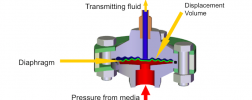Three specific types of errors have a negative impact on pressure sensor accuracy. This easy-to-understand video from WIKA explains the difference between zero-point errors, span errors, and non-linearity. Inaccuracies in pressure instrumentation occur when the …
Know-how
Diaphragm Seal Overview: Basic Principle and Applications
Chi-Che Ma | Know-howA diaphragm seal makes measuring pressure safer and more reliable – even in extreme working conditions – and is ideal for protecting pressure instrumentation and process transmitters. Discover the basic principle behind diaphragm seals and when to use them. It …
The Problems with Verifying Thermocouple Accuracy During Reactor Startups
Robert Torgerson | Know-howRefinery operators who work with fixed bed catalysts place a high value on temperature accuracy, but they also don’t want to waste time by taking unnecessary temperature readings. Thus, to better understand any radial temperature differences that may exist during …
What to Know about Aging and Drift in Type K Thermocouples
Robert Torgerson | Know-how, TemperatureWith repeated exposure to high temperatures, a Type K thermocouple becomes less accurate. Aging is a phenomenon that results in higher-than-accurate temperature readings, while drift results in lower-than-accurate readings. While all Type K thermocouples experience …
Pressure Transmitter Accuracy and Pressure Transmitter Non-Linearity: Not the Same Thing
Robert Lukat | Know-howSometimes, references to pressure transmitter accuracy are actually about the non-linearity of the pressure transmitter’s response. Although accuracy and non-linearity are related, the two terms are not the same and shouldn’t be used interchangeably. The …






